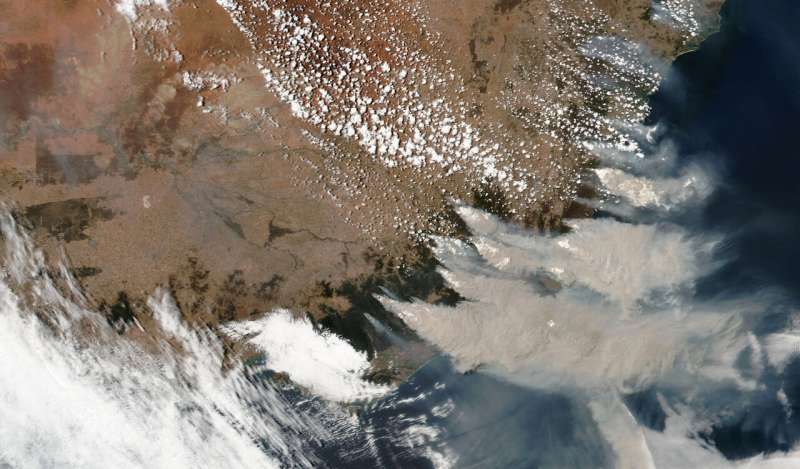This satellite image provided by NASA on Saturday, Jan. 4, 2020 shows wildfires in Victoria and New South Wales, Australia. Climate change raised the chances of Australia's extreme fire season by at least 30%, according to a study released Wednesday, March 4, 2020, by climate scientists at the World Weather Attribution group. (NASA via AP)
Climate change raised the chances of Australia's extreme fire season by at least 30%, according to a study released Wednesday by climate scientists at the World Weather Attribution group.
Scientists from Australia, Europe and North America calculated just how much human-caused global warming elevated the likelihood of Australia's record-setting fire season by comparing high-resolution computer models of the continent facing varying levels of climate change.
The scientists took into account differences in climate conditions in about 1900 compared to current conditions—tabulating both measured and observed changes in temperature, drought and fire intensity.
Last year was both the hottest and driest year on record in Australia since measurements began a century ago.
"There is evidence that Australian fire seasons have lengthened and become more intense—and extreme temperatures have played a role in this," said Sophie Lewis, a climate scientist at the University of New South Wales in Canberra, Australia, and a co-author of the study.
"Climate change is now part of Australia's landscape – extreme heat is clearly influenced by human-caused climate change, which can influence fire conditions," she said.
Australia's 2019-2020 wildfire season burned a record 19 million hectares (47 million acres), displacing thousands of people and killing at least 34. The fires also razed rare habitats and killed more than a billion animals, say researchers.
A decade ago, while scientists often discussed how climate change increased the likelihood of extreme weather patterns, researchers were still reluctant to explicitly connect any specific weather event with climate change.
Today, more precise computer models allow scientists to pinpoint the degree to which an altered climate influences the chances of individual extreme wildfires, floods, droughts and heatwaves.
Technology Review magazine – published by the Massachusetts Institute of Technology – recently named climate change attribution models as one of the "Breakthrough Technologies" of 2020.
"It's one thing to paint a broad statistical picture of how climate change is loading the dice for extreme weather events. But it's quite another to really dig into the climate data and specific numbers around an individual disaster, like the Australian wildfires," said Kim Cobb, a climate scientist at the Georgia Institute of Technology in Atlanta, who was not involved in the study.
"Reducing emissions remains the most important way to limit our climate risks," she said.
© 2020 The Associated Press. All rights reserved. This material may not be published, broadcast, rewritten or redistributed without permission.























